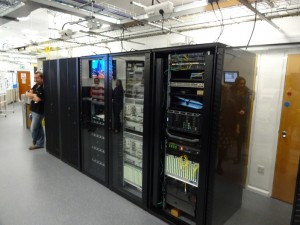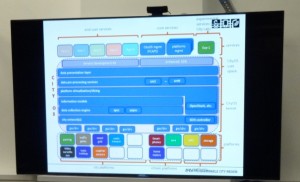Bristol to be world’s first programmable smart city
Filed under: News
The Bristol is Open programme is aiming to be the world’s first programmable city by opening up a scalable software defined network (SDN) operating system to researchers and companies.
The netOS operating system developed by the High Performance Computing group at the University of Bristol runs on the BlueCrystal supercomputer at the University and controls a network of 144 fibres across the city of Bristol, giving terabit/s of bandwidth. The key to the programme is that the network can be divided up into separate virtual ‘slices’ so that many applications can all run independently. This will allow individual applications from 100Mbit/s up to 100Gbit/s to be tested out, something which hasn’t been possible up until now, says Prof Dimitira Simeonidou, head of the research group and chief technology officer of Bristol is Open. All of this is combined into the CityOS and makes it fundamentally different to other smart cities such as Barcelona.
The network currently has four nodes connecting the University, the EngineShed business acceleration centre, the Watershed digital creative incubator and the @Bristol science centre. This will allow startups to use the network to develop new smart city hardware and applications. It will also allow the Planetarium at @Bristol to be used to display immersive 3D Ultra HD video over the network coupled with data from BlueCrystal.
Part of the aim is to be able to research future generations of technologies needed for mobile wireless, says . “We are researching 5G at the moment but this has to be able to support 10Gbit/s speeds for when 10G wireless comes along,” she said. Elements of this are already happening with Blu Wireless Technology using its 60GHz gigabit wireless technology to connect to the network.
The optical switches are coming from Polatis and BiO has signed a memorandum of understanding with NEC for more network equipment. It is also working with Silver Spring to install a mesh network using the WiSUN protocol on lampposts across the city to collect data. Bristol City Council will also make data from the city available as part of the programme.
The other key aspect is the ability to emulate, rather than simulate, other cities with many more nodes. The emulator is based on Xilinx FPGA cards and allows the network topology of other larger cities to be run on the BiO infrastructure. This would allow cities such as New York or Hong Kong to test out new topologies and applications for 1000 or 1500 nodes, using real infrastructure and real data, without impacting on the running of a megacity. And because the Bristol network is connected to high bandwidth academic networks such as SuperJANET, real data can be used to test out the emulation in real time. Bristol’s sister city of Guangzhou in China is already interested in using this capability.
Related articles
UK tech industry faces fragmented times – FT.com
So how easy is Bristol’s success to replicate asks the FT? The city’s digital entrepreneurs describe several key advantages.The area has a strong pool of workers with engineering expertise. For years, Bristol and its surroundings have been a base for microelectronics and aerospace companies. Hewlett-Packard, BAE Systems and Rolls-Royce have all had a substantial presence in recent times.
Another interesting statistic quoted in the article is that engineers are 30-50% cheaper in the region than in London.
via UK tech industry faces fragmented times – FT.com.
Blu Wireless shows its gigabit wireless modem chip technology
Blu Wireless Technology has been demonstrating its HYDRA gigabit modem technology in a chip at the Mobile World Congress trade show in Barcelona (see video below).
The baseband system IP for 60GHz wireless has been implemented in a 40nm CMOS chip that can be used for the ‘WiGig’ 802.11ad 60GHz version of wifi that is starting to get traction in laptops and talets. It can also be used for wireless Back Haul for LTE mobile networks and for other high speed networks such as Bristol is Open which formally launches tomorrow (as detailed in the January High Tech newsletter). Bristol startup BWT supplies a complete multi-Gigabit capable baseband processor with all the associated firmware so that customers can quickly build their own millimetre wave gigabit wireless modem chips.
“The successful validation and demonstration of our HYDRA Gigabit System IP represents a major milestone in Blu Wireless’s technology roadmap,” said Henry Nurser, Blu Wireless Technology CEO. “Customers looking to license HYDRA for their own millimetre wave products can now be confident in going to market with this class leading technology.”
HYDRA, developed in Bristol, is based on a unique and patented architecture, which combines software defined parallel processing functions. These are controlled using a MIPS microAptiv CPU with hardware accelerators for fixed communication functions. This allows customers to adapt and add value to wireless modem applications with unique algorithms for channel equalisation, modulation or beamforming – all programmable through the robust, industry standard software tools provided by Imagination Technologies for its MIPS CPUs. Imagination has two design centres in the region.
This collaboration with Imagination is vital, says Nurser to get the maximum performance and efficiency from the multiple MIPS CPUs in the design. “Blu Wireless has made excellent progress with their innovative HYDRA IP implementation on 40nm,” said Tony King-Smith, EVP of marketing at Imagination Technologies. “We’re impressed with the performance they have achieved, thanks in part to MIPS’ high-performance, power-efficient architecture for multi-core embedded designs, and our comprehensive MIPS tools. ”
Since late 2014 the lead HYDRA chip has been integrated with a 60 GHz phased array radio front-end to create Blu Wireless’s Lightning evaluation and development platform which are available now as well. The module integrates a full ‘OpenFlow’ SDN client which supports wireless mesh networking. It is currently being deployed as part of Bristol is Open to demonstrate gigabit rate wireless mesh networking for dynamic data backhaul applications.
The ‘Lightning’ module is integrated into a robust mechanical housing for deployment in outdoor applications and is available with a mounting kit for lamppost deployment.
Mark Barrett, CMO at Blu Wireless said: “The ‘Lightning’ module represents a total system solution for the next generation of flexible gigabit capable backhaul technologies. The unique combination of low profile 60 GHz phased array technology, gigabit modem and adaptive mesh networking using SDN ‘Openflow’ techniques will deliver lower TCO and scalable data delivery capabilities to service the increased data demand of mobile networks”
www.bluwirelesstechnology.com/
Related articles
Major survey to help region capitalise on digital opportunities
A major piece of research is being undertaken to ensure the West of England region capitalises on the huge opportunities the future of gaming, animation and visual effects will bring following the successful SW VR conference.
via Major survey to help West of England region capitalise on high-tech opportunities – Business Leader.
Somnium uses TVS for pre-launch testing
Bristol design tool startup Somnium Technologies is using the local expertise of TVS to test out its technology before its launch.
Somnium has developed a new way of developing embedded code to make the process much more reliable and bug free, and TVS performed important installation testing of Somnium DRT. This uses a patented resequencing technology to automatically optimise embedded software, resulting in smaller, faster executables. Before DRT’s general availability release, Somnium wanted to be confident of the best out of the box experience for its customers, who use a wide variety of host platforms, so it contacted TVS for its proven experience in this field.
“Installation is the first step in the user experience, and it is often under-tested in real-user scenarios,” said Dave Edwards, Founder and CEO/CTO of Somnium Technologies. “We felt it was best practise to bring in a level of independence and we naturally turned to TVS because of its expertise in this area.”
Jamie Packer, VP of Customer Engineering at Somnium added: “We already perform extensive automated testing of functionality and standards compliance using several test suites. However, it is impossible to automate the experience of new users with different expectations and a variety of hardware and software configurations. The testing performed by TVS was extremely useful and thorough. TVS tried a number of interesting corner cases. This has led to improvements in both the installation process and the documentation.”
“SOMNIUM is very proactive in recognising the importance of independent installation testing. Many companies overlook this aspect, and hence many new users report a negative experience when starting with a new tool,” said Mike Bartley, Founder and CEO of TVS.










